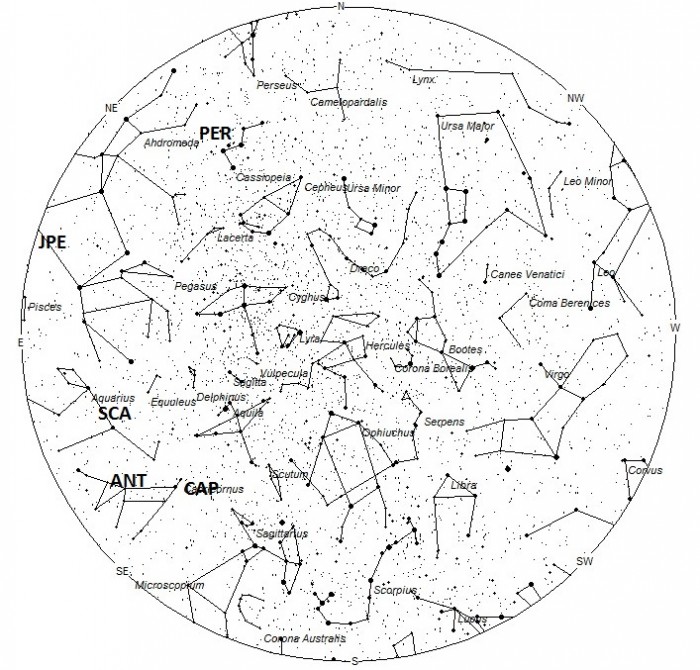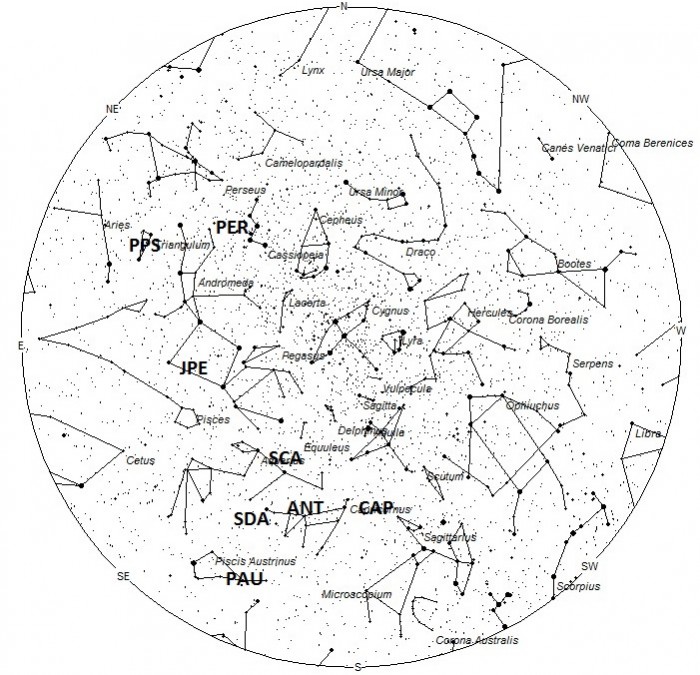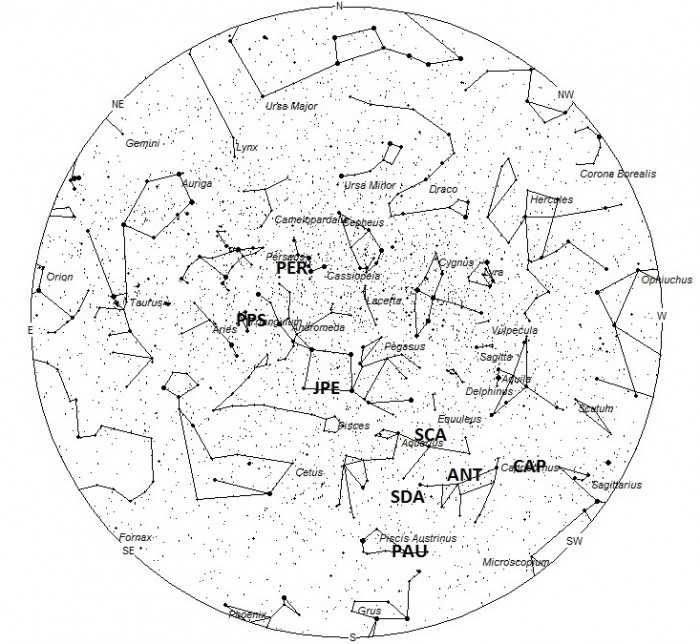During this period the moon reaches its full phase on Monday July 22nd. At this time the moon is located opposite the sun and will be in the sky most of the night as seen from mid-northern latitudes. As the week progresses the waning gibbous moon will rise later during the evening hours, but will still be in the sky during the more active morning hours, causing considerable interference with meteor viewing. The estimated total hourly meteor rates for evening observers this week is near two no matter your location. For morning observers the estimated total hourly rates should be near six no matter your location. The actual rates will also depend on factors such as personal light and motion perception, local weather conditions, alertness and experience in watching meteor activity. Rates are reduced during this period due to the interfering moonlight.
The radiant (the area of the sky where meteors appear to shoot from) positions and rates listed below are exact for Saturday night/Sunday morning July 20/21. These positions do not change greatly day to day so the listed coordinates may be used during this entire period. Most star atlases (available at science stores and planetariums) will provide maps with grid lines of the celestial coordinates so that you may find out exactly where these positions are located in the sky. A planisphere or computer planetarium program is also useful in showing the sky at any time of night on any date of the year. Activity from each radiant is best seen when it is positioned highest in the sky, either due north or south along the meridian, depending on your latitude. It must be remembered that meteor activity is rarely seen at the radiant position. Rather they shoot outwards from the radiant so it is best to center your field of view so that the radiant lies at the edge and not the center. Viewing there will allow you to easily trace the path of each meteor back to the radiant (if it is a shower member) or in another direction if it is a sporadic. Meteor activity is not seen from radiants that are located below the horizon. The positions below are listed in a west to east manner in order of right ascension (celestial longitude). The positions listed first are located further west therefore are accessible earlier in the night while those listed further down the list rise later in the night.
The table below presents a list of radiants that are expected to be active this week. Rates and positions are exact for Saturday night/Sunday morning. Details for each source will be presented again next week when the situation with moonlight improves.
| SHOWER | DATE OF MAXIMUM ACTIVITY | CELESTIAL POSITION | ENTRY VELOCITY | CULMINATION | HOURLY RATE | CLASS |
| RA (RA in Deg.) DEC | Km/Sec | Local Daylight Time | North-South | |||
| Alpha Capricornids (CAP) | Jul 30 | 20:00 (300) -13 | 25 | 01:00 | 1 – 2 | II |
| Anthelions (ANT) | – | 20:44 (311) -17 | 30 | 02:00 | <1 – 1 | II |
| Sigma Capricornids (SCA) | Jun 27 | 21:36 (324) -01 | 42 | 03:00 | <1 – <1 | IV |
| Delta Aquariids (SDA) | Jul 30 | 21:56 (334) -19 | 42 | 04:00 | 1 – 2 | I |
| Pisces Austrinids (PAU) | Jul 28 | 22:04 (336) -34 | 35 | 04:00 | <1 – <1 | II |
| July Pegasids (JPE) | Jul 10 | 23:44 (356) +13 | 68 | 05:00 | <1 – <1 | IV |
| Perseids (PER) | Aug 12 | 01:00 (015) +52 | 61 | 06:00 | 1 – <1 | I |
| Phi Piscids (PPS) | Jul 01 | 01:56 (029) +32 | 69 | 07:00 | <1 – <1 | IV |
 American Meteor Society
American Meteor Society



I saw two big red fireballs at 4:00 am on July 26th. After they went passed which was crazy fast there was a puff in the sky. I live in Coronach Saskatchewan.